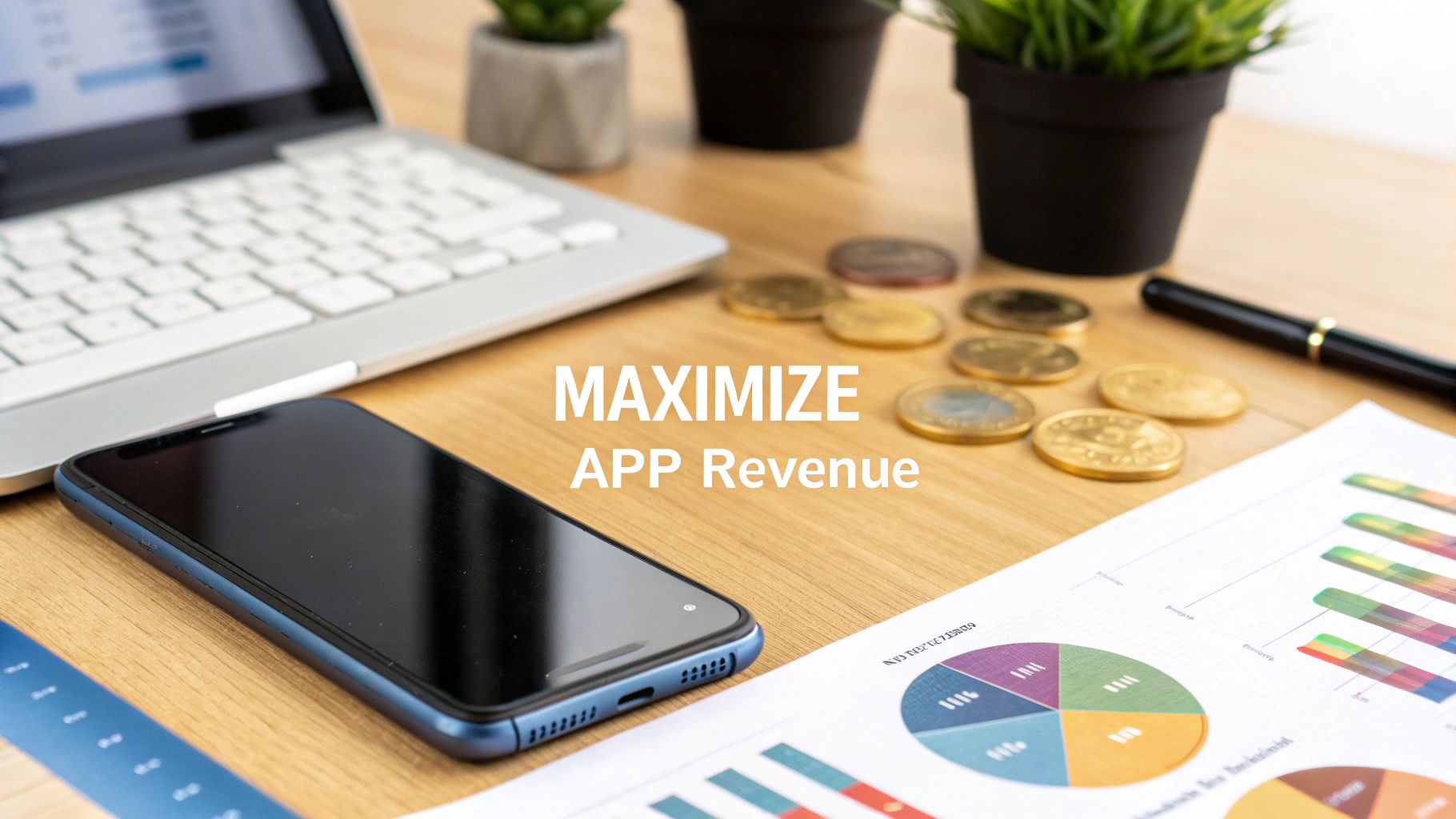Developing a groundbreaking mobile app is only half the battle; the real challenge lies in turning downloads into dollars. With the app economy more competitive than ever, choosing the right monetization approach is critical for sustainable success. A flawed or mismatched strategy can alienate your user base and stifle growth, while a well-executed one can transform a popular app into a thriving business. This is why understanding the full spectrum of available mobile app monetization strategies is not just an option, it's a necessity for survival and scalability.
This guide moves beyond surface-level definitions to provide a comprehensive deep-dive into the most effective revenue models available today. We will dissect the mechanics behind each strategy, weigh its specific pros and cons, and highlight which app categories it suits best. For Omaha-based businesses, startups, and e-commerce retailers, making an informed decision early on can significantly impact your bottom line and long-term viability. Many developers find success by combining approaches; to delve deeper into various revenue generation models, explore these 9 proven mobile app monetization strategies for 2025.
Whether you're launching a new app or looking to optimize an existing one, this roundup provides the actionable insights and practical examples needed to select the perfect model. From the popular Freemium and Subscription models to more nuanced approaches like Data Monetization and Sponsorships, you'll gain the clarity required to build a sustainable revenue stream that aligns with your app's purpose and your users' expectations. Let's explore how to unlock your app's full financial potential.
1. Freemium Model
The Freemium model stands as one of the most popular and effective mobile app monetization strategies, attracting a broad user base by offering core functionality for free. The core principle is simple: provide a valuable, albeit limited, free version of your app to capture a large audience and then convert a small percentage of those users into paying customers by offering premium features, an ad-free experience, or expanded content.
This strategy works by demonstrating the app's value firsthand. Users get comfortable with the interface and core features, making the decision to upgrade for a better experience a natural next step. The free tier acts as a powerful marketing tool, driving downloads and organic word-of-mouth growth without an initial payment barrier.
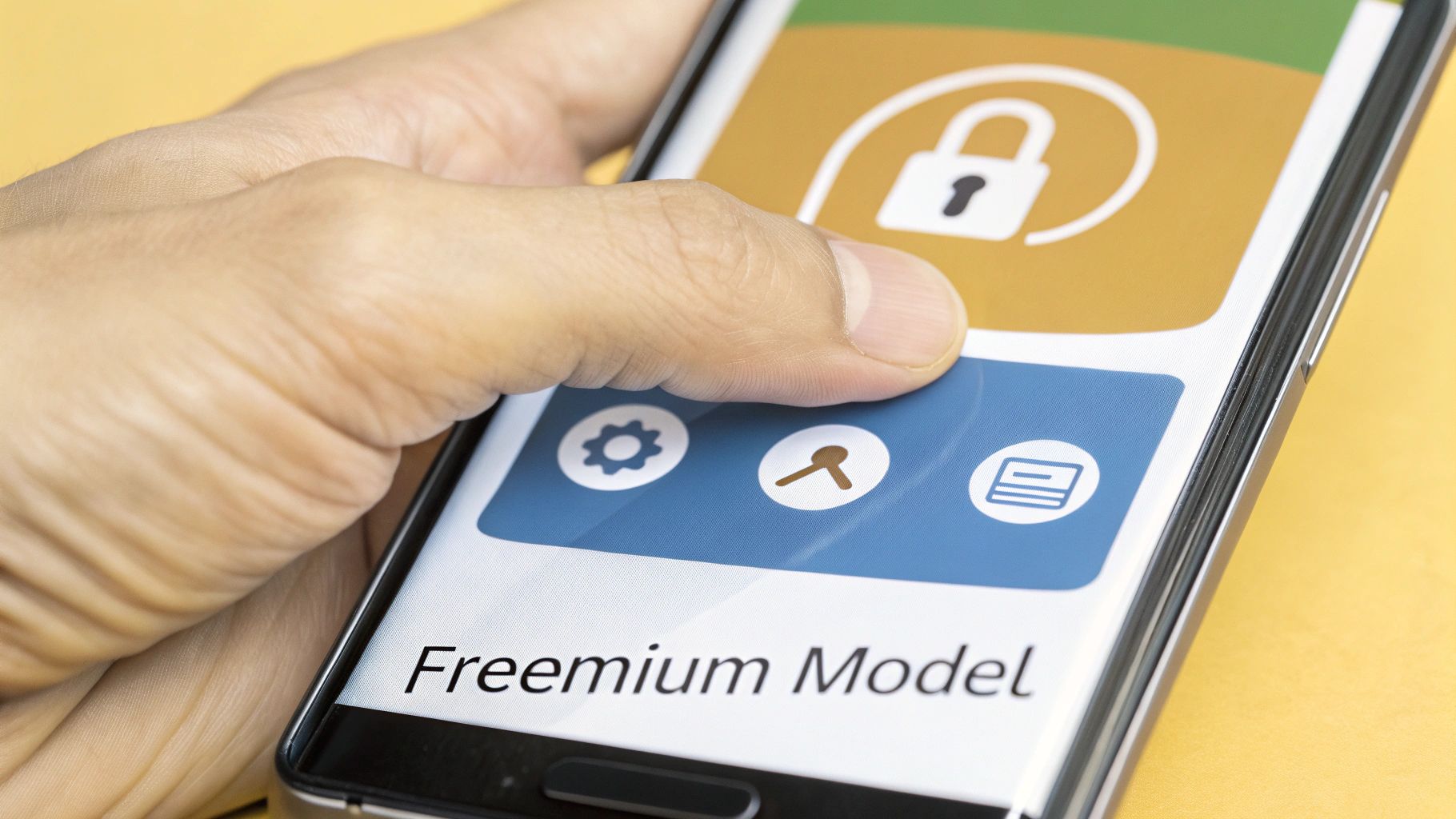
How to Implement the Freemium Model
Successfully executing a freemium strategy requires a delicate balance between the free and paid tiers. The free version must be useful enough to retain users, while the premium version needs to offer compelling value that justifies the cost.
- Valuable Free Tier: Ensure the free version solves a real problem for the user. A crippled or frustrating free experience will lead to high churn rates, not conversions.
- Strategic Paywalls: Identify the features that your most engaged users value and place them behind a paywall. Use data analytics to understand which functionalities are most likely to drive an upgrade.
- Offer Premium Trials: Give users a taste of the premium experience with a time-limited free trial. This is a proven method for demonstrating value and increasing conversion rates. A user who experiences an enhanced feature is more likely to pay to keep it.
- Analyze User Behavior: Continuously monitor how users interact with both free and premium features. A/B test different pricing tiers, feature combinations, and promotional offers to optimize your conversion funnel.
Excellent examples of this model include Spotify, which offers free music with ads and limitations, and Canva, which provides robust design tools for free but reserves its best templates and features for Pro subscribers.
2. In-App Advertising
In-app advertising is one of the most widely used mobile app monetization strategies, allowing developers to generate revenue by displaying advertisements within their application. This model is particularly effective for apps with a large user base, as it enables the core content to remain free, thereby maximizing downloads and engagement. Revenue is typically earned based on impressions (CPM), clicks (CPC), or specific user actions (CPA).
The primary advantage of this strategy is its ability to monetize non-paying users. By integrating ads, you can generate a consistent income stream from your entire audience, not just the small fraction who might opt for a paid upgrade. This approach makes it a go-to choice for casual games, social media platforms, and utility apps.
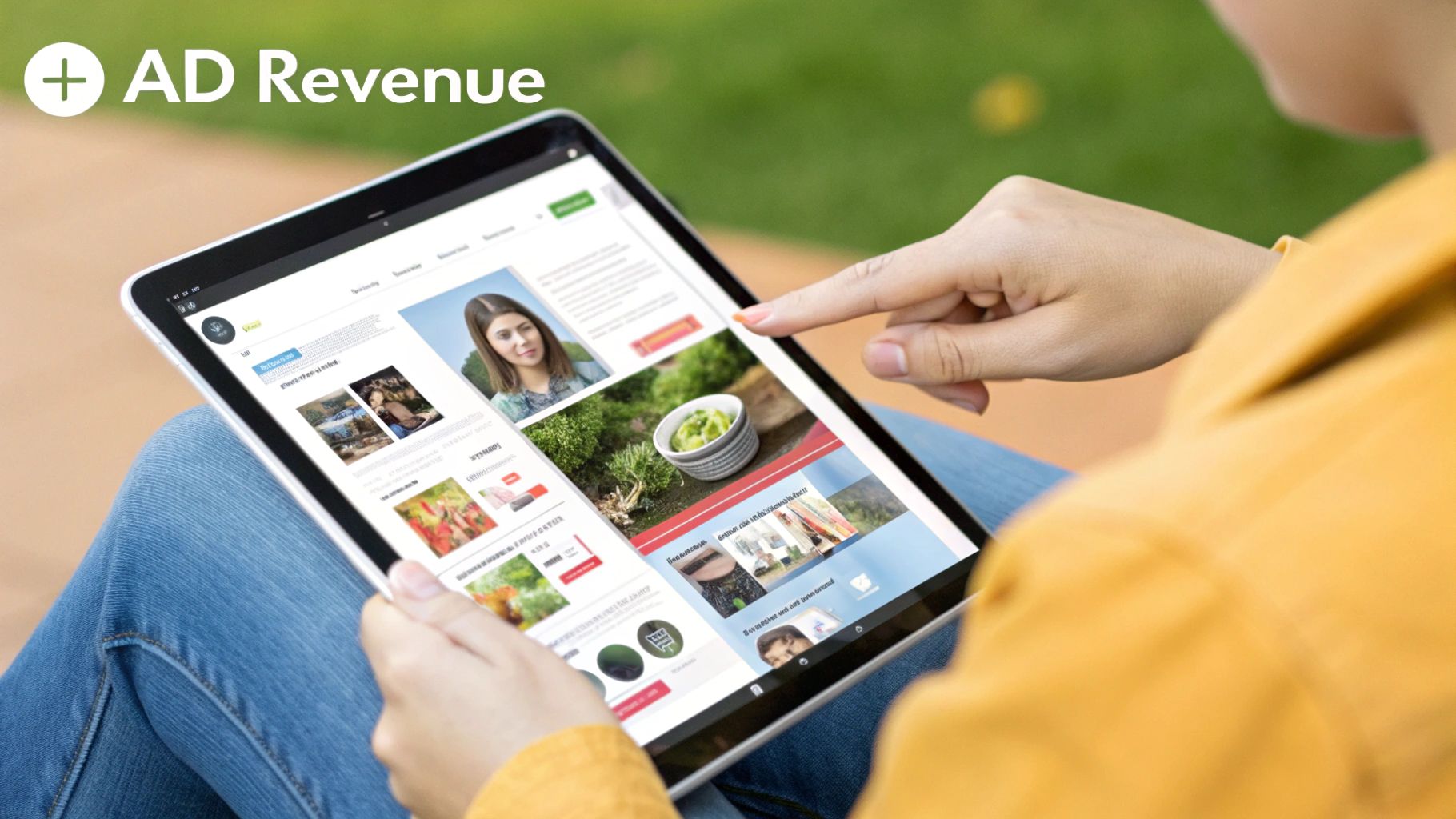
How to Implement In-App Advertising
A successful in-app advertising strategy hinges on balancing revenue generation with a positive user experience. Overloading your app with intrusive ads can drive users away, so a thoughtful implementation is crucial for long-term success.
- Choose the Right Ad Formats: Experiment with different formats like banner ads, interstitial ads (full-screen ads at natural pauses), native ads that blend into the app's design, and rewarded video ads that offer users in-app benefits for watching.
- Prioritize User Experience: Place ads at natural break points in the user flow, such as after completing a level in a game or between content segments. Avoid interrupting core tasks, which can frustrate users and lead to uninstalls.
- Use Ad Mediation Platforms: Integrate a mediation platform like Google AdMob or AppLovin to serve ads from multiple networks. This creates competition for your ad inventory, automatically filling it with the highest-paying ad and maximizing your revenue.
- Offer an Ad-Free Option: Complement your ad strategy by offering an in-app purchase to remove all ads. This creates a hybrid model, catering to users who prefer an uninterrupted experience and providing an additional revenue stream.
Classic examples include Instagram, which seamlessly integrates sponsored posts into its feed, and the free versions of Duolingo and Angry Birds, which use interstitial ads between lessons and levels.
3. In-App Purchases (IAP)
In-App Purchases (IAP) represent one of the most direct and versatile mobile app monetization strategies, allowing developers to sell a variety of digital goods and services directly from within their application. This model can be integrated into both free and paid apps, generating revenue by offering users optional items that enhance their experience, speed up progress, or unlock new content.
The strength of the IAP model lies in its flexibility. Revenue is tied directly to user engagement and perceived value, as users choose what and when to buy. From one-time consumables like extra lives in a game to permanent non-consumables like a new photo filter, IAPs create a continuous revenue stream post-download, driven by the app's most dedicated users.
How to Implement In-App Purchases
A successful IAP strategy hinges on creating desirable items and presenting them in a way that feels valuable, not exploitative. The goal is to enhance the user experience, not create frustrating paywalls that drive users away.
- Offer Compelling Value: Your purchasable items must provide a clear benefit. Whether it's a "starter pack" for new users at a discount or a premium tool for power users, the value proposition should be obvious.
- Create Scarcity and Urgency: Implement limited-time offers or exclusive bundles to encourage immediate purchases. This can significantly boost conversion rates by tapping into the fear of missing out.
- Implement Tiered Pricing: Provide a range of price points, from small microtransactions (e.g., $0.99) to larger, high-value bundles (e.g., $99.99). This caters to different user spending habits and maximizes revenue potential.
- Simplify the Purchase Flow: Make the first purchase as frictionless as possible. A complicated or lengthy checkout process is a major conversion killer. Reduce the number of taps required to complete a transaction.
Classic examples of this model include gaming giants like Candy Crush Saga, which sells boosters and extra moves, and Clash of Clans, which offers gems to accelerate gameplay. Productivity apps also use it, like Procreate selling custom brush packs to artists.
4. Subscription Model
The Subscription Model has become one of the most powerful and reliable mobile app monetization strategies, shifting the focus from one-time purchases to long-term customer relationships. In this model, users pay a recurring fee, typically weekly, monthly, or annually, for continuous access to your app’s content, features, or services. This provides a predictable and stable revenue stream, making financial forecasting easier for your business.
This strategy excels by delivering ongoing value, encouraging high user retention and loyalty. Rather than a single transaction, the subscription model builds a durable connection with your audience, who see the app as an integral service worth paying for regularly. This steady income allows for continuous app improvement and content updates.
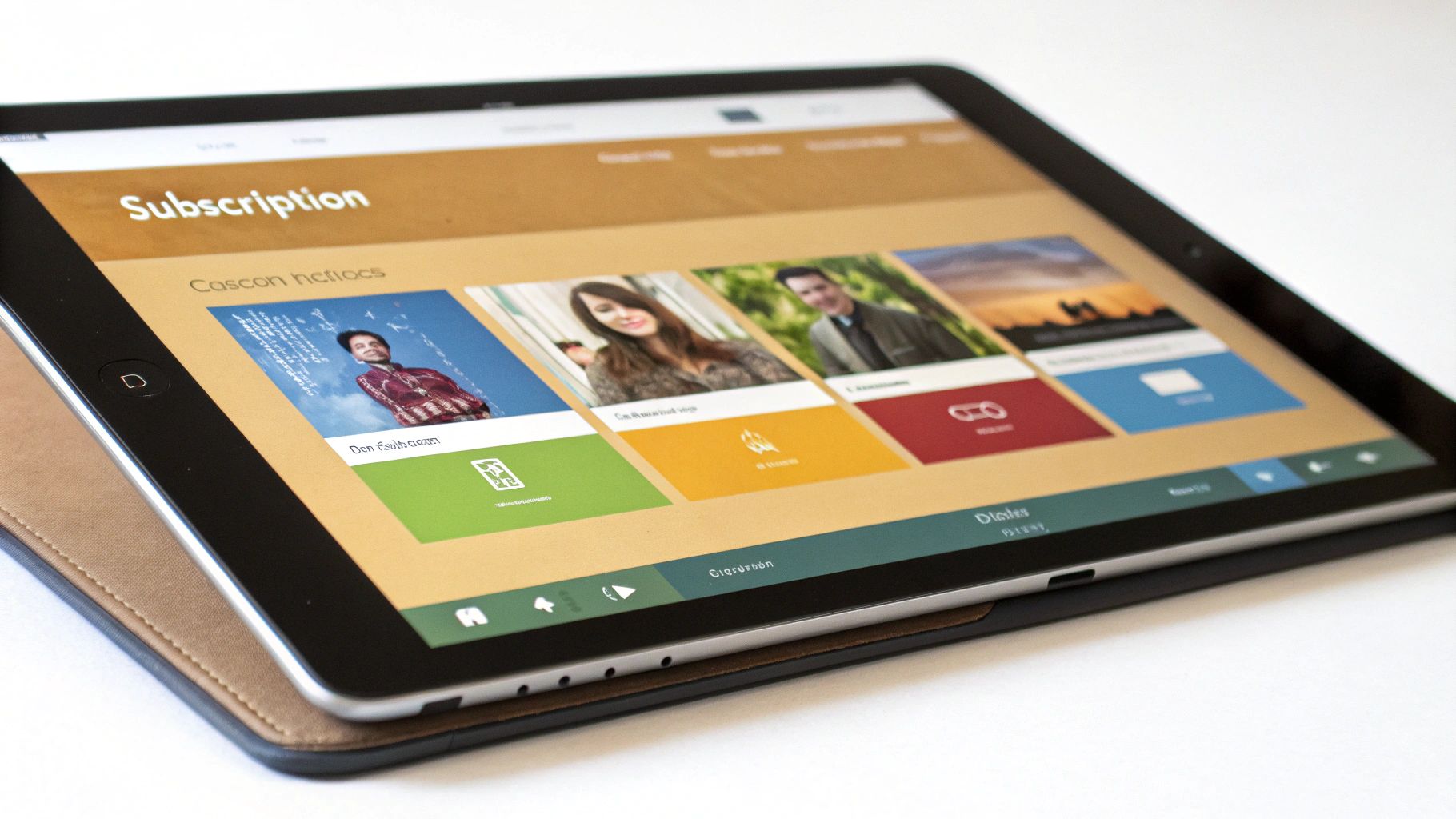
How to Implement the Subscription Model
A successful subscription model hinges on consistently proving its value to prevent churn. The content or service must remain compelling enough for users to justify the recurring payment. Integrating this model from the initial MVP app development stage can help align your product's core value with long-term user engagement.
- Offer Compelling Trials: Provide a 7-day or 14-day free trial to let users experience the full value of your premium offering, which significantly boosts conversion rates.
- Create Tiered Plans: Design multiple subscription tiers (e.g., Basic, Pro, Premium) to cater to different user needs and budgets, maximizing your potential customer base.
- Incentivize Annual Plans: Price your annual plan at a discount, equivalent to 10 or 11 months of the monthly fee, to secure upfront revenue and improve retention.
- Analyze Churn Patterns: Use cohort analysis to understand why and when users cancel. Implement winback campaigns with special offers to re-engage churned subscribers. For a deeper dive into how this model is implemented across various businesses, explore these 7 Subscription Business Model Examples for Creators.
Prominent examples of this model include Netflix for streaming content, Calm for wellness and meditation, and Duolingo Plus for an ad-free language learning experience.
5. Paid App Model
The Paid App model is the most traditional of all mobile app monetization strategies, requiring users to pay a one-time, upfront fee to download and use the application. This straightforward approach generates revenue directly from each download, providing an immediate return on investment. Once a user pays, they typically gain full access to all features without recurring charges or advertisements.
This strategy establishes a clear value proposition from the start. Users understand they are purchasing a premium product, which can lead to higher expectations but also a more dedicated user base. It works best for apps that offer a distinct, high-value function that cannot be easily replicated for free, such as specialized productivity tools, high-quality games, or professional-grade creative software.
How to Implement the Paid App Model
Success with a paid app hinges on convincing potential users of its value before they ever download it. Your app store presence becomes your primary sales tool, and building trust is paramount.
- Invest in App Store Optimization (ASO): Your app’s title, description, screenshots, and preview videos must be highly compelling. They need to clearly communicate the app's unique selling points and justify its price tag.
- Build Social Proof: Positive reviews and high ratings are critical. Encourage satisfied users to leave feedback, as this heavily influences the purchasing decisions of prospective customers.
- Price Strategically: Set your price based on perceived value, competitor pricing, and the specific niche you are targeting. Consider offering a lower introductory price at launch to build initial momentum.
- Provide Continuous Value: Justify the upfront cost by releasing regular updates that add new features, fix bugs, and improve the user experience. This keeps your app relevant and shows commitment to your customers.
Prime examples of this model include the immensely popular game Minecraft ($6.99), the powerful illustration app Procreate ($12.99), and the innovative puzzle game Monument Valley ($3.99).
6. Sponsorship and Partnership Model
The sponsorship and partnership model is a highly effective mobile app monetization strategy that involves collaborating with other brands. Instead of charging users directly, your app generates revenue by having companies pay for direct association, featured placement, or content integration that reaches your dedicated audience.
This approach works best when an app has cultivated a specific, engaged niche audience that is valuable to potential sponsors. The partnership can take many forms, from sponsoring a specific feature to co-branded content or even exclusive integrations. This creates a revenue stream that feels organic and can enhance the user experience if the partner alignment is strong.
How to Implement the Sponsorship and Partnership Model
Successful implementation hinges on finding the right partners and creating value for both them and your users. The key is to integrate sponsorships in a way that feels authentic rather than intrusive.
- Build a Targeted Audience: Before seeking sponsors, focus on growing a substantial and well-defined user base. Sponsors pay for access to a valuable demographic.
- Ensure Brand Alignment: Partner with brands whose values and products resonate with your users. A partnership between a fitness app and a sports apparel brand feels natural and adds value.
- Create Clear Sponsorship Tiers: Develop packaged offerings with clear deliverables and pricing. This could range from a simple logo placement to a fully integrated, sponsored challenge or feature.
- Use Data to Prove Value: Leverage user analytics to demonstrate the value of your audience to potential sponsors. Showcase engagement rates, demographics, and user behavior to make a compelling case.
Excellent examples include Strava, which partners with sports brands like Garmin and New Balance, and Waze, which features sponsored location pins from businesses like McDonald's and Dunkin'. These partnerships provide revenue while offering relevant content to users.
7. Affiliate Marketing Model
The Affiliate Marketing model is a performance-based mobile app monetization strategy where you earn a commission by promoting third-party products or services within your app. Revenue is generated when a user clicks on a referral link and completes a desired action, such as making a purchase, signing up for a service, or installing another app.
This approach allows you to monetize your user base without charging them directly. By integrating relevant product or service recommendations, you add value for your users while creating a new income stream. The key is to align the promoted offerings with your app's content and your audience's interests, making the promotions feel like genuine, helpful suggestions rather than intrusive ads.
How to Implement the Affiliate Marketing Model
Success with affiliate marketing hinges on trust and relevance. The products you promote should be high-quality and directly related to your app's purpose to maintain user credibility and drive conversions.
- Maintain Transparency: Always disclose your affiliate relationships to your users. This builds trust and is often required by law and by the terms of service of affiliate networks like Amazon Associates.
- Focus on Relevance: Promote products and services that genuinely benefit your users. A recipe app, for instance, could provide affiliate links to purchase ingredients from a grocery delivery service.
- Use Deep Linking: Whenever possible, use deep links that take users directly to the specific product page within another app or on a mobile website. This frictionless experience significantly improves conversion rates.
- Track and Optimize: Monitor which affiliate links and products generate the most clicks and revenue. Use this data to refine your strategy, testing different product placements and promotional tactics to maximize earnings.
Prime examples of this model include travel apps like Skyscanner, which earns commissions from airlines and booking sites, and content-driven apps like Wirecutter, which monetizes its expert product reviews through affiliate links to retailers.
8. Data Monetization Model
The Data Monetization model is one of the more complex mobile app monetization strategies, focusing on generating revenue by collecting, analyzing, and sharing anonymized and aggregated user data. This data is valuable to third parties like marketers, researchers, and analytics firms who use it to understand market trends, consumer behavior, and demographic patterns.
This approach hinges on scale and user trust. An app must have a substantial user base to generate a data set large enough to be statistically significant and valuable. Crucially, this model requires absolute transparency with users about what data is collected and how it is used, demanding strict adherence to privacy regulations like GDPR and CCPA.
How to Implement the Data Monetization Model
Executing a data monetization strategy responsibly is paramount to avoiding legal issues and maintaining user trust. The focus must be on ethical data handling and providing clear value to the user in exchange for their consent.
- Implement Transparent Privacy Policies: Clearly and simply state what data you collect and why. Avoid legal jargon and make your policy easily accessible within the app.
- Obtain Explicit Opt-In Consent: Never assume consent. Users must actively agree to have their anonymized data collected and shared. This is a non-negotiable legal and ethical requirement.
- Anonymize and Aggregate Data: Ensure all personally identifiable information (PII) is removed. Data should be bundled into large, anonymous groups to protect individual privacy and report on general trends.
- Partner with Reputable Buyers: Vet any third parties you plan to share data with. Partner only with ethical companies that have strong data protection standards to safeguard your users and your brand.
A prime example is GasBuddy, which aggregates user-reported fuel prices to provide insights to analytics firms. Similarly, navigation apps like Waze use anonymous location data to create real-time traffic reports, demonstrating how data-driven insights can enhance the core app experience.
9. Transaction Fee Model
The Transaction Fee model is a powerful approach among mobile app monetization strategies where the platform acts as a digital intermediary, facilitating transactions between two parties. Instead of charging users for access or features, the app generates revenue by taking a small percentage commission or a flat fee from each transaction it processes.
This strategy is highly effective for marketplace, booking, and payment gateway apps because the revenue scales directly with the platform's utility and transaction volume. The model's success hinges on creating a secure and valuable ecosystem that attracts both buyers and sellers, or service providers and consumers, encouraging them to conduct business through your app. Your app's value is tied directly to the value it creates for its users.
How to Implement the Transaction Fee Model
A successful transaction fee strategy requires building trust and demonstrating clear value that justifies your commission. The fee must be perceived as fair for the convenience, security, and access your platform provides.
- Be Transparent: Clearly disclose all fees to both parties before a transaction is finalized. Hidden charges erode trust and can lead to high user churn.
- Establish Trust and Security: Invest heavily in secure payment processing, fraud prevention systems, and user verification. Features like ratings, reviews, and buyer/seller protection policies are crucial for building confidence.
- Offer Competitive Rates: When launching, research your competitors and set your fee structure to be competitive, if not lower, to attract an initial user base. You can adjust rates as your platform's value grows.
- Incentivize High-Volume Users: Consider implementing tiered pricing or volume discounts for power users to encourage loyalty and increase transaction frequency. Understanding your revenue streams is key, and you can learn more about how to measure ROI to track your profitability.
Prominent examples of this model include Airbnb, which charges fees to both guests and hosts, and Uber, which takes a commission from every ride fare. Etsy also thrives on this model, charging listing fees, transaction fees, and payment processing fees.
10. Hybrid Monetization Model
The Hybrid model is one of the most sophisticated and powerful mobile app monetization strategies, enabling developers to maximize revenue by combining multiple methods. Instead of relying on a single income stream like ads or subscriptions, this approach diversifies revenue by catering to different user segments and their unique spending habits. It allows an app to serve non-paying users with ads while offering paying users an ad-free premium experience.
This strategy works by creating a flexible ecosystem where various monetization techniques coexist and complement one another. For instance, a freemium app might show rewarded ads to free users, offer in-app purchases for one-time boosts, and sell a premium subscription that removes all ads and unlocks exclusive content. This multi-pronged approach reduces financial risk and can significantly increase the average revenue per user (ARPU).
How to Implement the Hybrid Monetization Model
A successful hybrid strategy requires careful planning to ensure the different monetization layers feel natural and not intrusive. The goal is to create multiple value propositions that appeal to distinct user groups without creating a confusing or frustrating experience.
- Segment Your Audience: Analyze user data to identify different segments, such as casual users, power users, and those willing to spend. Tailor specific monetization offers to each group.
- Create Complementary Models: Ensure your chosen methods work together. For example, offering a subscription to remove ads is a classic synergistic pairing. Rewarded ads can also be used to give free users a taste of premium currency, encouraging future in-app purchases.
- Provide Clear Upgrade Paths: Make it obvious how users can transition from one monetization tier to another. Clearly communicate the benefits of purchasing a subscription or an in-app item, such as an ad-free experience.
- Test and Optimize: Continuously monitor the performance of each revenue stream. Use A/B testing to experiment with different combinations, price points, and ad placements to find the optimal balance for both revenue and user satisfaction.
Leading examples like Duolingo master this model, combining ads, a premium subscription (Super Duolingo), and in-app purchases for "gems" to create a highly effective and diverse revenue engine.
12. Hybrid Monetization Model
The Hybrid model is an advanced approach that combines two or more mobile app monetization strategies to maximize revenue potential. Instead of relying on a single method like in-app advertising or subscriptions alone, this model strategically blends them to cater to different user segments and create multiple, diversified income streams.
This strategy acknowledges that a one-size-fits-all approach doesn't work for a diverse user base. Some users might tolerate ads but never make a purchase, while others will gladly pay to remove them or unlock premium content. By offering various options, you can capture revenue from a much broader audience, effectively increasing your Average Revenue Per User (ARPU) and reducing financial risk.
The following infographic highlights the core benefits of adopting a hybrid monetization framework.
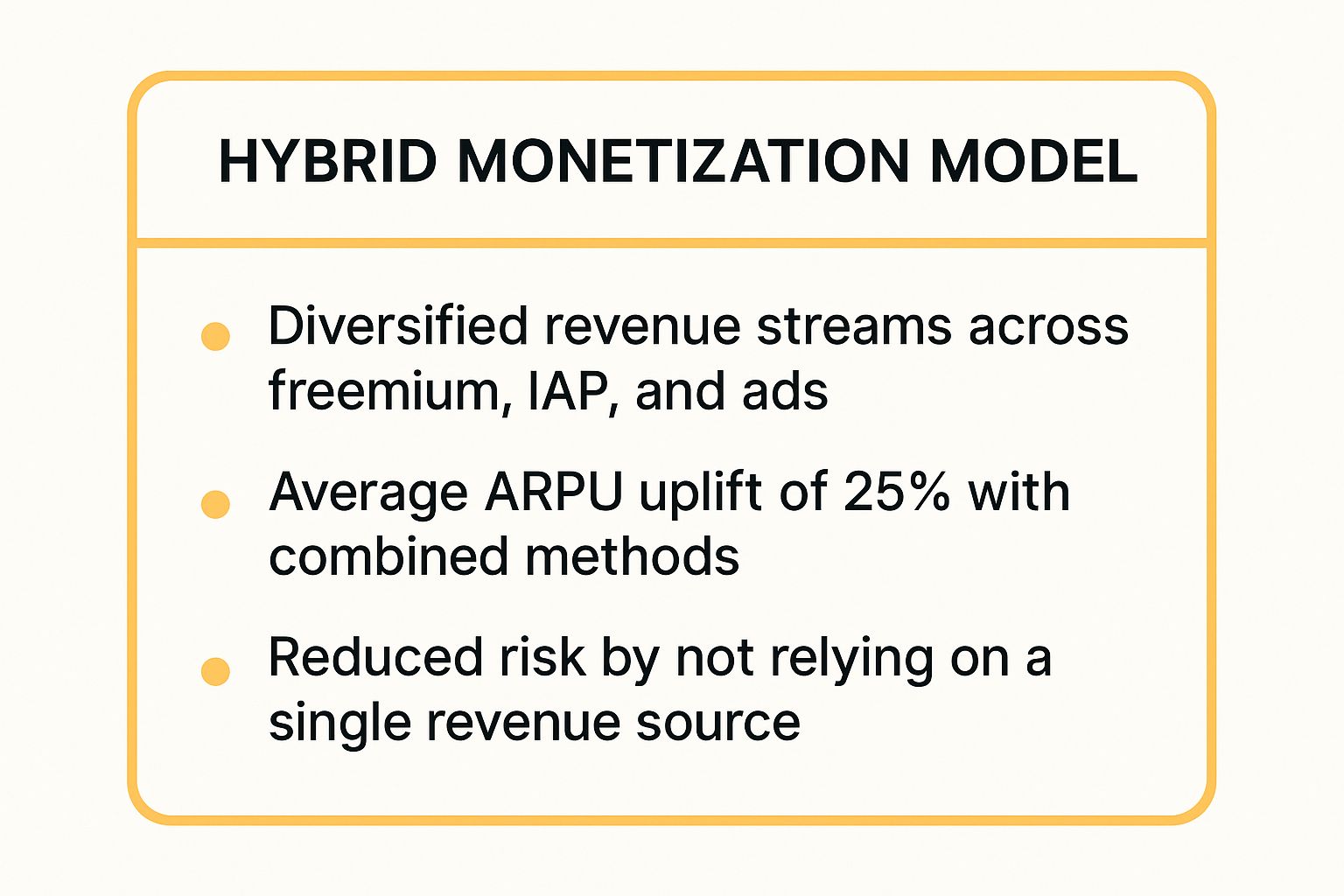
As the data shows, combining methods can significantly lift ARPU while providing a more stable, resilient revenue foundation for your app.
How to Implement the Hybrid Model
A successful hybrid strategy requires careful planning and a deep understanding of user behavior to ensure the different monetization layers complement, rather than conflict with, each other.
- Segment Your Audience: Identify different user groups. For instance, casual users might be monetized through rewarded video ads, while power users are targeted with premium subscription offers.
- Offer Choices: Allow users to pay to remove ads. This classic hybrid tactic combines In-App Advertising with an In-App Purchase, catering to both price-sensitive users and those who prioritize a premium experience.
- Balance and Test: Ensure that one monetization method doesn't cannibalize another. A/B test different combinations, such as the frequency of ads shown to non-subscribers, to find the optimal balance that maximizes overall revenue without harming user retention.
Gaming apps like Clash of Clans master this model by combining in-app purchases for virtual goods with occasional promotional offers and video ads for in-game rewards.
Mobile App Monetization Strategies Comparison
| Model | Implementation Complexity 🔄 | Resource Requirements ⚡ | Expected Outcomes 📊 | Ideal Use Cases 💡 | Key Advantages ⭐ |
|---|---|---|---|---|---|
| Freemium Model | Moderate - Requires feature gating and analytics | Moderate - Server costs for free users | Scalable revenue, low conversion rates (2-5%) | Broad appeal apps, scalable features | Low entry barrier, viral growth potential |
| In-App Advertising | Moderate - Ad integration and targeting | Low - Mainly ad network setup | Passive income scaling with user engagement | High traffic, free-to-use apps | Free app experience, multiple ad formats |
| In-App Purchases (IAP) | High - Payment integration, virtual economy | Moderate to high - Payment management | High revenue from engaged users (1-5% buy) | Gaming, content apps, productivity tools | Flexible pricing, recurring revenue |
| Subscription Model | High - Recurring billing and tier management | Moderate to high - Ongoing content delivery | Predictable, recurring revenues, high LTV | SaaS, streaming, content, productivity | Recurring revenue, long-term retention |
| Paid App Model | Low - One-time purchase setup | Low - Simple payment integration | Upfront revenue, limited growth potential | Premium games, professional apps, niche markets | Immediate revenue, clean UX |
| Sponsorship & Partnership | High - Negotiation and brand integration | Moderate - Partnership management | High-value deals, variable revenue | Niche, health, travel, engaged communities | Less intrusive ads, brand credibility |
| Affiliate Marketing | Low to moderate - Link integration, tracking | Low - Affiliate network participation | Variable commission revenue | Content-driven, shopping, lifestyle apps | No inventory, performance-based income |
| Data Monetization | High - Data collection, compliance | Moderate to high - Legal and security | Passive, high-value data revenue | Large user base, behavior-tracking apps | Monetizes existing data, complements models |
| Transaction Fee Model | High - Payment processing and dispute systems | High - Compliance, fraud prevention | Revenue scales with transactions | Marketplaces, gig economy, booking platforms | Aligns success with transactions, sticky users |
| Hybrid Monetization | Very high - Multiple models integration | High - Advanced analytics and management | Revenue diversification, optimized ARPU | Mature apps, gaming, social, diverse user bases | Revenue diversification, flexibility |
Build a Monetization Engine That Drives Growth
Navigating the landscape of mobile app monetization strategies is far more than a one-time decision; it's the beginning of a dynamic, strategic journey. As we've explored, the path from a great app idea to a profitable business is paved with choices, from the ubiquitous Freemium and In-App Advertising models to the more direct Paid App and Subscription approaches. We’ve seen how In-App Purchases can drive revenue through consumable and non-consumable goods, while innovative methods like Sponsorships, Affiliate Marketing, and Data Monetization open entirely new revenue streams. Each model presents a unique psychological contract with your user, shaping their experience, expectations, and willingness to pay.
The core takeaway is that there is no universal "best" strategy. A monetization model that creates a billion-dollar valuation for a gaming app could alienate the entire user base of a productivity tool. The right choice is deeply contextual, rooted in your app's core value proposition, your target audience's behavior, and your long-term business goals. An e-commerce platform in Omaha might thrive on a Transaction Fee model, whereas a local digital publisher would find more success with a blend of Subscriptions and targeted In-App Advertising.
From Strategy Selection to Sustainable Revenue
Choosing a model is merely step one. The real art lies in execution, optimization, and evolution. The most successful app developers treat monetization not as a static feature but as a living component of their product, one that requires constant attention and refinement. This is where a data-driven mindset becomes your most valuable asset.
Your actionable roadmap should include:
- Hypothesize and Test: Start with the model that seems most aligned with your app's purpose. For example, if your app provides continuous, evolving content, a Subscription model is a strong starting point. If it offers a core utility with optional power-ups, Freemium with IAPs makes more sense.
- Implement Analytics Early: Before you even think about A/B testing price points, ensure you have robust analytics in place. Track key metrics like Daily Active Users (DAU), Average Revenue Per User (ARPU), Customer Lifetime Value (LTV), and churn rate. These numbers are the vital signs of your monetization health.
- Segment Your Audience: Not all users are created equal. Some are "whales" willing to spend significantly, while others will never pay a dime but contribute value through engagement and network effects. Use analytics to segment your audience and tailor offers, promotions, and even the user experience to each group.
- Embrace the Hybrid Approach: As we discussed, you don't have to be a purist. The most sophisticated mobile app monetization strategies are often hybrids. A content app might use a subscription model as its primary engine but supplement it with affiliate links for recommended products. A game might be freemium but offer a one-time "ad-free" purchase or a premium subscription for exclusive content.
The Human Element of Monetization
Ultimately, successful monetization is built on a foundation of user trust and perceived value. Aggressive, intrusive, or confusing monetization tactics will inevitably backfire, leading to negative reviews, high uninstall rates, and a damaged brand reputation.
Key Insight: Your revenue strategy must enhance, not detract from, the user experience. When users feel they are receiving fair value in exchange for their money or attention, they are more likely to become loyal, paying customers and brand advocates.
Always ask yourself: Does this ad placement disrupt the core user flow? Is this subscription price justified by the value we provide every month? Is our IAP structure transparent and fair? Answering these questions with the user's perspective in mind will guide you toward building a monetization engine that is not only profitable but also sustainable. By continuously listening to user feedback, analyzing behavioral data, and adapting to market trends, you can transform your mobile app from a passion project into a powerful, growth-driving enterprise.
Ready to architect a mobile app with a monetization strategy built for profitability from the ground up? The experts at Up North Media specialize in developing custom applications with robust, scalable revenue frameworks tailored to your business goals. Contact Up North Media today to build an app that not only engages users but also drives sustainable growth.
